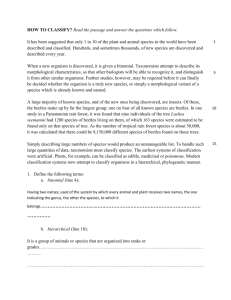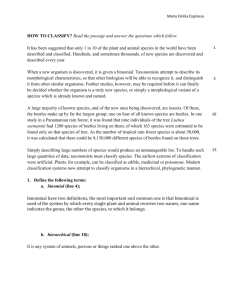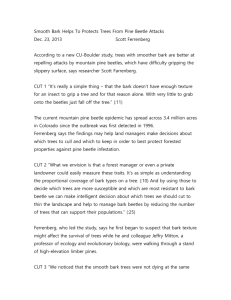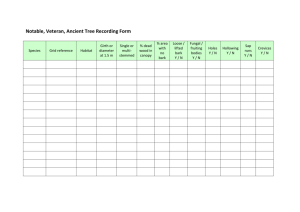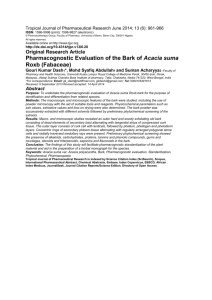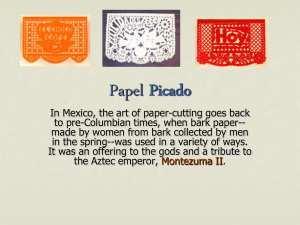Jakub Horák: Introduction to Forest Protection Chapter X
advertisement
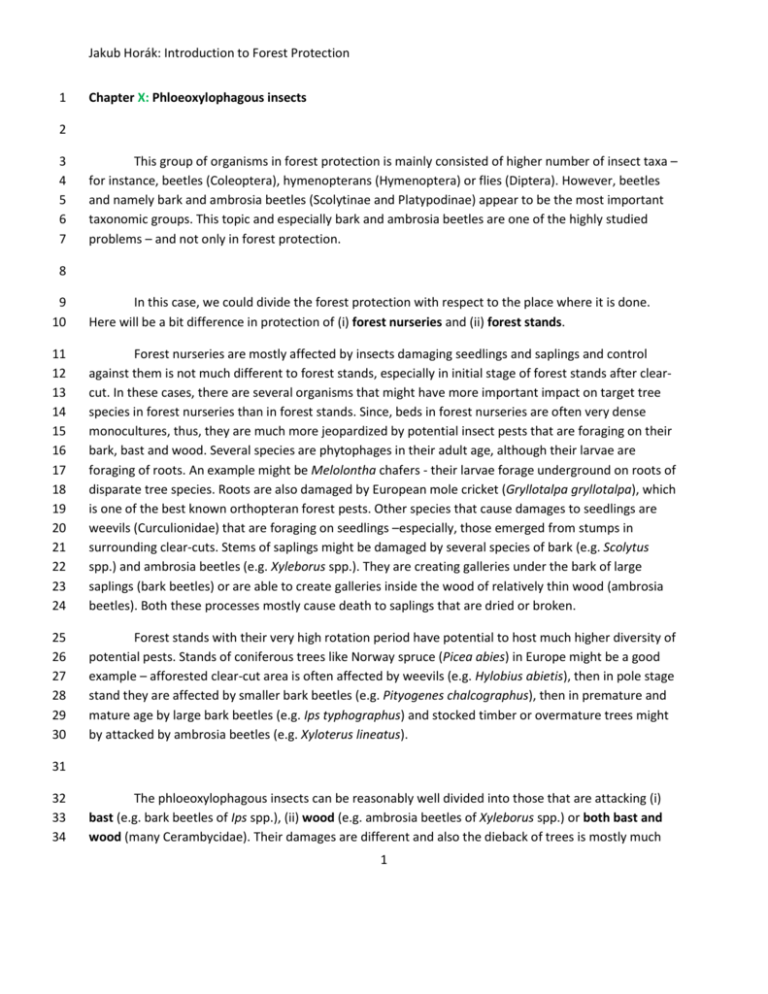
Jakub Horák: Introduction to Forest Protection 1 Chapter X: Phloeoxylophagous insects 2 3 4 5 6 7 This group of organisms in forest protection is mainly consisted of higher number of insect taxa – for instance, beetles (Coleoptera), hymenopterans (Hymenoptera) or flies (Diptera). However, beetles and namely bark and ambrosia beetles (Scolytinae and Platypodinae) appear to be the most important taxonomic groups. This topic and especially bark and ambrosia beetles are one of the highly studied problems – and not only in forest protection. 8 9 10 In this case, we could divide the forest protection with respect to the place where it is done. Here will be a bit difference in protection of (i) forest nurseries and (ii) forest stands. 11 12 13 14 15 16 17 18 19 20 21 22 23 24 Forest nurseries are mostly affected by insects damaging seedlings and saplings and control against them is not much different to forest stands, especially in initial stage of forest stands after clearcut. In these cases, there are several organisms that might have more important impact on target tree species in forest nurseries than in forest stands. Since, beds in forest nurseries are often very dense monocultures, thus, they are much more jeopardized by potential insect pests that are foraging on their bark, bast and wood. Several species are phytophages in their adult age, although their larvae are foraging of roots. An example might be Melolontha chafers - their larvae forage underground on roots of disparate tree species. Roots are also damaged by European mole cricket (Gryllotalpa gryllotalpa), which is one of the best known orthopteran forest pests. Other species that cause damages to seedlings are weevils (Curculionidae) that are foraging on seedlings –especially, those emerged from stumps in surrounding clear-cuts. Stems of saplings might be damaged by several species of bark (e.g. Scolytus spp.) and ambrosia beetles (e.g. Xyleborus spp.). They are creating galleries under the bark of large saplings (bark beetles) or are able to create galleries inside the wood of relatively thin wood (ambrosia beetles). Both these processes mostly cause death to saplings that are dried or broken. 25 26 27 28 29 30 Forest stands with their very high rotation period have potential to host much higher diversity of potential pests. Stands of coniferous trees like Norway spruce (Picea abies) in Europe might be a good example – afforested clear-cut area is often affected by weevils (e.g. Hylobius abietis), then in pole stage stand they are affected by smaller bark beetles (e.g. Pityogenes chalcographus), then in premature and mature age by large bark beetles (e.g. Ips typhographus) and stocked timber or overmature trees might by attacked by ambrosia beetles (e.g. Xyloterus lineatus). 31 32 33 34 The phloeoxylophagous insects can be reasonably well divided into those that are attacking (i) bast (e.g. bark beetles of Ips spp.), (ii) wood (e.g. ambrosia beetles of Xyleborus spp.) or both bast and wood (many Cerambycidae). Their damages are different and also the dieback of trees is mostly much 1 Jakub Horák: Introduction to Forest Protection 35 36 37 38 39 40 41 42 43 44 45 quicker in the case of bark beetles than ambrosia beetles. Bark beetles that are feeding in bast appear to be more important, because many species of them have more than one generation per vegetation season and thus they are able to cause serious damages to the stands more times per year. It is also known that bark beetles are more important in boreal and temperate forests and their impact is replaced by ambrosia beetles when closing to Equator. In tropical forests bark and ambrosia beetles can have overlapped generations through the year. The impact of insects that are feeding in both bast and wood appears to be lower in temperate and boreal forests, although some alien species might have very high local impact on native ecosystems and also on target trees within harvested woodland landscapes. Presently several jewel (Buprestidae) and longhorn beetles (Cerambycidae) are of high importance, e.g. in eastern states of the U.S.A. One of serious threats is also association of phloeoxylophagous insects with alien associates like in elm bark beetles and fungi or association of some longhorns with nematodes. 46 47 48 The active forest protection against phloeoxylophages is mostly based on (i) chemical and (ii) mechanical approaches. 49 50 51 As an example of chemical protection in forest nurseries is use of pheromone traps – even if mostly un-effective. The mechanical approaches are, for instance, application of bark traps on weevils or burning of material that was attacked by pests. 52 53 54 55 56 57 58 59 60 61 62 63 Forest stands have again more complex system in protection against phloeoxylophages. The main used approaches are pheromone baited traps and tree traps, or combination of them – like triplet logs with pheromone and furthermore, with application of contact insecticide. All these kinds of traps are often used for monitoring of actual population densities of phloeoxylophagous insects. Presently, there are highly selective pheromones for particular insect species. All these systems have, of course their drawbacks like relatively short intervals of control of pheromone baited traps, because the trapping success of target insect species is lowering with rising time interval and number of non-target and often beneficial insects is rising. In the case of highly effective tree traps, should be mentioned need for early deactivation of this trap, which means peeling of the bark during the time of last larval stages or spraying by insecticides immediately before emerging of immature beetles. Triplets are relatively thoughtless approach (many beneficial insects are killed) and should be used only in badly accessible areas, where the interval between controls is highly limited-e.g. in mountains. 64 65 66 67 At the end, there might be good to say that three phloeoxylophagous insects are indexed in the law of the Czech Republic as pests that might cause calamities in forests – Ips typhographus, Pityogenes chalcographus and Hylobius abietis. 68 2 Jakub Horák: Introduction to Forest Protection 69 70 71 72 Fig. X. Last generation of the year of the Spruce Bark beetle (Ips typographus). Immature (brown) adults are mostly at the end of former larval galleries. Some part of them will overwinter under the bark, while majority will emerge and overwinter in forest soil. 73 3 Jakub Horák: Introduction to Forest Protection 74 75 76 77 78 Fig. X. The activity of Oak Pinhole borer (Platypus cylindrus) is highlighted by piles of fibrous frass that were handed out by adults during the creation of galleries in sapwood of oak stump. This borer has associated filamentous fungi that are distributed by adults in mycangia on their thorax and those fungi infested the oak wood and are diet for Oak Pinhole borer larvae. 79 80 81 82 Example 1: Karvemo S., Van Boeckel T.P., Gilbert M., Gregoire J.C., Schroeder M. (2014) Large-scale risk mapping of an eruptive bark beetle–Importance of forest susceptibility and beetle pressure. Forest Ecology and Management 318: 158-166. 83 84 85 86 Attacks by spruce bark beetle (Ips typhographus) on Norway spruce (Picea abies) forest stands can cause huge damage in Europe. This bark beetle is the most important pest beetle in Europe. Its population densities have increased during the recent years. Except of mountainous and boreal parts of its distribution (i.e. native distribution of Norway spruce), has this species more generations per season. 87 88 89 Karvemo et al. (2014) made the risk-rating models for damages caused by this bark beetle. They studied this species in temperate part of Sweden and used predictors like volume of Norway spruce and Birch wood volume per hectare, mean tree height, distance to the clear cuts, presence of bark beetle 4 Jakub Horák: Introduction to Forest Protection 90 91 92 93 infestation spots and number of infestation spots in the neighborhood. They found that increasing volume of the Norway spruce was the only one significant predictor that positively influenced relative risks of infestation by the spruce bark beetle. They also found that the trees killed by the spruce bark beetle in managed forest landscapes are distributed in many small infestation spots. 94 95 96 97 Example 2: Lubojacky J., Holusa J. (2013) Comparison of lure-baited insecticide-treated tripod trap logs and lure-baited traps for control of Ips duplicatus (Coleoptera: Curculionidae). Journal of Pest Science 86: 483-489. 98 99 100 101 102 103 Double-spined bark beetle (Ips duplicatus) is presently spreading in Europe. The species has nearly the same requirements as most important pest of Norway spruce in Europe – Ips typhographus. With respect to forest protection against bark beetles, mostly three measures are used – trap trees, pheromone baited traps or pheromone baited tripods that are treated by insecticide. Even if, trap trees appears to be the most efficient, they bring relative risk when they are not debarked in the right time before new adults emerged. 104 105 106 107 108 109 Lubojacky & Holusa (2013) studied the difference between pheromone baited traps or pheromone baited tripods that are treated by insecticide. They found that commonly used pheromone traps were nearly three times more efficient in captures of the double-spined bark beetle. Furthermore, pheromone traps captured more females than males, while tripods lured and killed males and females in the same ratio. Both types of traps were more efficient during spring months than in summer. Moreover, tripods killed significantly higher number of beneficial and non-target insects than pheromone traps. 110 111 112 113 Example 3: Zas R., Sampedro L., Prada E., Lombardero M.J., Fernandez-Lopez J. (2006) Fertilization increases Hylobius abietis L. damage in Pinus pinaster Ait. seedlings. Forest Ecology and Management 222: 137-144. 114 115 116 117 118 119 120 Pine weevil (Hylobius abietis) has intricate ecology. Adults are feeding on bark of young stems and they are partly saproxylic in stumps Larvae are feeding in fresh stumps and furthermore also in stems of young seedlings. Adults live for more years and preferred clear cuts with fresh stumps of conifers. One of the best measures in forest protection against this species is to leave the afforestation to the second year, when stumps are more decayed and thus not so attractive for the Pine weevil. Maritime pine (Pinus pinaster) is the most important forest tree species in Spanish Galicia. Fertilization is a commonly recommended for second-generation Maritime pine plantations. 121 122 123 Zas et al. (2006) studied damages caused by the Pine weevil in Maritime pine (Pinus pinaster) plantations in Spain. They found that fertilization (combinations of ammonium nitrate, calcium phosphate, potassium sulphate and magnesium sulphate) had a strong and significantly positive effect 5 Jakub Horák: Introduction to Forest Protection 124 125 126 on pine weevil damage. The damage by the pine weevil was greater on fertilized plants. The loss on seedlings against unfertilized control was nearly four times higher. Moreover, no significant effect of fertilization on growth of seedling of Maritime Pine was observed. 127 128 129 130 Example 4: Muller J., Bussler H., Gossner M., Rettelbach T., Duelli P. (2008) The European spruce bark beetle Ips typographus in a national park: from pest to keystone species. Biodiversity and Conservation 17: 2979-3001. 131 132 133 134 135 The spruce bark beetle (I. typographus) is considered as one of the major pests in European forests. On the other hand, it is known that if the areas with high nature conservation value are attacked by this beetle and are left for succession, the biodiversity often rapidly grows. The bark beetle surely have high potential as ecosystem engineer that is creating habitats for many other organisms and is also opening the canopy of high forests. 136 137 138 139 140 141 Muller at al. (2008) studied this bark beetle in Germany. They compared forests, gaps created by man and gaps created by spruce bark beetle. Species richness of three studied taxa – bugs (Heteroptera), bees and wasps (Hymenoptera) and saproxylic beetles (Coleoptera) was higher in gaps than in forests. Saproxylic beetles were more species rich in gaps created by bark beetle and the same result was reached for threatened species. Authors concluded that that Ips typographus fulfils the majority of criteria for a keystone species, particularly those that help to maintenance of biodiversity in forests. 142 143 144 145 Example 5: Bertheau C., Salle A., Rossi J.P., Bankhead-Dronnet S., Pineau X., Roux-Morabito G., Lieutier F. (2009) Colonisation of native and exotic conifers by indigenous bark beetles (Coleoptera: Scolytinae) in France. Forest Ecology and Management 258: 1619-1628. 146 147 148 149 150 151 Exotic trees are often planted as ornamental plants in non-forest habitats. The growth of some of them indicated that they have high potential for forestry and timber production. North American tree species Sitka spruce (Picea sitchensis), Eastern white pine (Pinus strobus), Grand fir (Abies grandis), Douglas fir (Pseudotsuga menziesii) and Western red cedar (Thuja plicata) are among them. In any case, exotic trees have some potential from the point of view of native organisms – and also potential pests including bark beetles. 152 153 154 155 156 157 Bertheau et al. (2009) studied colonization of three native conifers – Norway spruce (Picea abies), Scots pine (Pinus sylvestris) and Silver fir (Abies alba) – and five above mentioned north-American conifers by native bark beetles. The study was done in France. The main aim of study was to estimate factors causing shift of bark beetles onto new host trees. While using window traps, they collected eighteen indigenous and furthermore two exotic bark beetles. Surprisingly, all exotic conifer species were colonized by indigenous bark beetles and no significant difference was observed between native 6 Jakub Horák: Introduction to Forest Protection 158 159 160 and exotic tree species. They found that the ability of indigenous bark beetles to shift onto exotic conifers depend on host tree species, the presence of phylogenetically related native conifers and that of similar resources, in combination with insect host specificity. 161 162 163 164 Example 6: Boone C.K., Aukema B.H., Bohlmann J., Carroll A.L., Raffa K.F. (2011) Efficacy of tree defense physiology varies with bark beetle population density: a basis for positive feedback in eruptive species. Canadian Journal of Forest Research 41: 1174-1188. 165 166 167 168 169 Lodgepole pine (Pinus contorta) is a fire-dependent conifer that is widely distributed in western North America. This species has been planted also in other parts of the world. Mountain pine beetle (Dendroctonus ponderosae) is native in forests of North America. This species is associated with Blue stain fungus (Grosmannia clavigera). The mountain pine beetle outbreak recently destroyed wide areas of lodgepole pine forest. 170 171 172 173 174 175 Boone et al. (2011) studied in Canada potential factors in resistance of lodgepole pine to the bark beetle attack. They evaluated the ability of constitutive and inducible defenses to protect trees and restrict herbivore reproduction across disparate eruptive phases of outbreak. Host tree defenses were important only when mountain pine beetle populations were low. Trees of large diameter had more pronounced defenses. However, as populations increased, beetles selected increasingly larger, more resource-rich trees. 176 177 178 Example 7: Ayres M.P., Wilkens R.T., Ruel J.J., Lombardero M.J., Vallery E. (2000) Nitrogen budgets of phloem-feeding bark beetles with and without symbiotic fungi. Ecology 81: 2198-2210. 179 180 181 182 183 Many bark beetles (Scolytinae) have their own and sometimes species-specific fungal or bacterial (present research revealed also other organisms like mites, nematodes or protozoans etc.) associates. These associates often help them during the attack and killing of host trees. Some of them help them during the feeding and food digestion. On the other hand, host trees have many types of mechanism that help them against the insect attack. 184 185 186 187 188 189 190 Ayres et al. (2000) studied the influence of nitrogen in food on development of bark beetles with and without symbiotic fungi. They used loblolly pine (Pinus taeda) as a host tree and the southern pine beetle (Dendroctonus frontalis) with symbiotic fungi and eastern five-spined bark beetle (Ips grandicollis) without symbionts as its herbivores. The nitrogen content of plant tissue is rather low and low level of nitrogen as a part of a diet can limit the growth and reproduction of bark beetles. Phloem (bast) is very low in content of nitrogen and often contains poisonous substances. Mycangial fungi provide their benefits by concentrating dietary nitrogen for larvae. Trees with higher nitrogen content produced larger 7 Jakub Horák: Introduction to Forest Protection 191 192 southern pine beetle adults. Non-mycangial bark beetles meet their nitrogen budgets through high consumption of unaltered phloem with low content of nitrogen. 193 194 195 196 Example 8: Mezei P., Grodzki W., Blazenec M., Jakus R. (2014) Factors influencing the wind-bark beetles’ disturbance system in the course of an Ips typographus outbreak in the Tatra Mountains. Forest Ecology and Management 312: 67-77. 197 198 199 Abiotic and biotic disturbances are often interconnected. Bark beetle outbreak that followed disturbance caused by windstorms is rather frequent. The amount of bark beetle salvage cuttings is rising in areas where the salvage cutting after windstorm failed or was delayed. 200 201 202 203 204 Mezei et al. (2014) studied factors that potentially influenced the interconnected system between wind and bark beetles. The study was done in mountainous area in Slovakia and Poland. The disturbance system (wind-bark beetle) was primarily influenced by forest stand factors (stand age and related changes in Norway spruce size and vitality). However, stand, site and solar radiation were the most important factors causing tree mortality in the epidemic phase. 205 206 Questions for exam: 207 208 209 210 1. Bark beetles might cause dieback of target forest trees in large areas of forests. In initial stage of outbreak, they mostly attack one or few weakened trees in one place of forest stand. If they kill the tree(s), they further spread to other areas of forest. What is the most used strategy of their spread at the forest stand level (< 10ha)?: 211 212 213 214 2. Bark beetles from genus Ips are one of the most important enemies for weakened conifer trees in Europe. These bark beetles are able to attack relatively healthy trees. What is their strategy with respect to feeding and creating of galleries?: 215 216 217 218 3. Clear-cut areas are highly attractive for many insect species and taxa. They offer high sun-exposure and high dimension dead wood in the form of stumps. What is the main group of insects that are causing damages on artificial seedlings in clear-cut areas?: 219 220 221 4. Ambrosia beetles (e.g. Platypodinae or genus Xyleborus) are mostly creating their galleries in sapwood of trees. Their adults have symbiotic fungi in their mycangia and these fungi are infesting beetle galleries. 8 Jakub Horák: Introduction to Forest Protection 222 223 224 Fungi are known as ambrosia. Larvae are feeding on ambrosia and galleries get dark during the feeding process due to succession of fungal communities. The main impact of ambrosia beetles in forest protection occurs in: 225 226 227 228 5. Sawflies (Hymenoptera) are one of the most important non-coleopteran (i.e. non-beetle) phloeoxylophages in forest protection. They have symbiotic fungi that helped them infest the tree and also during the feeding. Sawflies are species from: 229 230 231 232 6. There are many species that are able to attack trees and feeding under the bark. Early arrivals are able to kill more or less healthy mature trees. Which groups of phloeoxylophages appears to be the most important with respect to commercial losses in forest protection?: 233 234 235 236 237 7. Bark and ambrosia beetles (Scolytinae and Platypodinae) are often associated with other organisms that help them to feed under the bark or in the wood. These associations are mostly beneficial to both taxa – beetles and associates, thus this relationship is called as symbiosis. Which organisms are the prevailing associates of bark and ambrosia beetles of subfamilies Scolytinae and Platypodinae?: 238 239 240 241 242 8. There are many ways how to protect forest stands against bark beetle attacks. Some of them are highly effective (e.g., trapping of high number of individuals), although some of them have several drawbacks (e.g., lowering efficiency during time period). What are the most effective methods in forest protection against bark beetles?: 9
